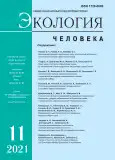STATISTICAL ANALYSIS OF THE RELATIONSHIP BETWEEN SOCIO-HYGIENIC FACTORS AND THE DISEASES OF BLOOD AND BLOOD-FORMING ORGANS IN THE PRIMORSKY REGION
- 作者: Ermolitskaya M.Z.1,2, Kiku P.F.3, Abakumov A.I.1
-
隶属关系:
- Institute of Automation and Control Processes of the Far Eastern Branch of the Russian Academy of Sciences
- Vladivostok State University of Economics and Service
- Far Eastern Federal University
- 期: 卷 28, 编号 11 (2021)
- 页面: 33-41
- 栏目: Articles
- URL: https://journals.rcsi.science/1728-0869/article/view/89915
- DOI: https://doi.org/10.33396/1728-0869-2021-11-33-40
- ID: 89915
如何引用文章
全文:
详细
作者简介
M. Ermolitskaya
Institute of Automation and Control Processes of the Far Eastern Branch of the Russian Academy of Sciences; Vladivostok State University of Economics and Service
Email: ermmz@mail.ru
кандидат биологических наук, доцент, старший научный сотрудник
P. Kiku
Far Eastern Federal University
A. Abakumov
Institute of Automation and Control Processes of the Far Eastern Branch of the Russian Academy of Sciences
参考
- Белишева Н. К., Петров В. Н. Проблема здоровья населения в свете реализации стратегии развития Арктической зоны Российской Федерации // Труды Кольского научного центра РАН. 2013. № 6 (19). С. 152-173
- Головин C. В., Петросян C. Л. Прогнозирование и моделирование развития заболеваемости в Воронежской области // Вестник Воронежского государственного технического университета. 2009. Т. 5, № 3. C. 4-8
- Государственный доклад «О состоянии санитарно-эпидемиологического благополучия населения в Приморском крае в 2020 году» / Федеральная служба по надзору в сфере защиты прав потребителей и благополучия человека. 2021. 324 c
- Жапаров К. А., Аралбаева А. Р., Таирова Ж. С. Социально-гигиенические проблемы образа жизни и состояния здоровья населения, проживающего в сельской местности // Вестник Ошского государственного университета. 2015. № 3. С. 48-54
- Иванов А. Г., Герасимова Л. И., Шувалова Н. В., Денисова Т. Г. Прогнозирование уровня заболеваемости и смертности от болезней системы кровообращения на региональном уровне на основе его многофазного математического моделирования // Медицинский альманах. 2012. № 3 (22). C. 20-24
- Кику П. Ф, Ярыгина М. В., Горборукова Т. В., Бениова С. Н. Влияние социально-гигиенических факторов среды обитания биоклиматических зон Приморского края на здоровье детей и подростков // Экология человека. 2016. № 4. С. 9-13. doi: 10.33396/1728-0869-2016-4-9-13
- Клейн С. В., Вековшинина С. А., Сбоев А. С. Приоритетные факторы риска питьевой воды и связанный с этим экономический ущерб // Гигиена и санитария. 2016. Т. 95, № 1. С. 10-14. doi: 10.18821/0016-9900-2016-95-1-10-14
- Клинская Е. О. Оценка влияния социально-экономических показателей на заболеваемость населения Еврейской автономной области // Вестник Российского университета дружбы народов. Серия: Экология и безопасность жизнедеятельности. 2011. № 2. С. 49-54
- Кондратьев М. А. Методы прогнозирования и модели распространения заболеваний // Компьютерные исследования и моделирование. 2013. Т. 5, № 5. C. 863-882
- Суранова Г. Ж., Тухватшин Р. Р., Казиева А. А., Намазбеков М. Н. Регрессионный анализ заболеваемости и смертности населения Кыргызской республики от болезней системы кровообращения // Современные проблемы науки и образования. 2017. № 6. URL: http://science-education. ru/ru/article/view?id=27347 (дата обращения: 12.02.2021)
- Трифонова Т. А., Марцев А. А. Оценка влияния загрязнения атмосферного воздуха на заболеваемость населения Владимирской области // Гигиена и санитария. 2015. Т. 94, № 4. С. 14-18
- Федеральная служба государственной статистики: официальный сайт: URL: https://rosstat.gov.ru (дата обращения: 12.02.2021)
- Цыплухина Ю. В., Бельских Н. В., Скрыпникова Е. А. Экологообусловленные заболевания и возможные пути их преодоления // Качество и жизнь. 2017. № 4 (16). С. 58-61
- Шабунова А. А., Рыбакова Н. А., Тихомирова Г. В. Факторы, ограничивающие здоровье населения региона (на примере Вологодской области) // Социологические исследования. 2009. № 8 (304). С. 85-91.
- Шитиков В. К., Мастицкий С. Э. Классификация, регрессия и другие алгоритмы Data Mining с использованием R. Тольятти: Сreative Commons, 2017. 351 с. URL: https://github.com/ranalytics/data-mining (дата обращения: 12.02.2021)
- Analitis A., Katsouyanni K., De Donato F., Scortichini M., Michelozzi P., Lanki T., Basagana X., Ballester F., Astrom C., Paldy A., Pascal M., Gasparrini A. Synergistic effects of ambient temperature and air pollution on health in Europe: Results from the phase project. International Journal of Environmental Research and Public Health. 2018, 15 (9), p. 1856. doi: 10.3390/ijerph15091856
- Florence L. Chiang, Max Feng, Rebecca S. Romero, at all. Disruption of the Atrophy-based Functional Network in Multiple Sclerosis Is Associated with Clinical Disability: Validation of a Meta-Analytic Model in Resting-State Functional MRI. Radiology. 2021. doi: 10.1148/radiol.2021203414
- Soares G. P., Klein C. H., Silva N. A., Oliveira G. M. Progression of mortality due to diseases of the circulatory system and human development index in Rio de Janeiro municipalities. ArquivosBrasileiros de Cardiologia. 2016, 107 (4), pp. 314-22.
- World Health Organization. URL: https://gateway.euro.who.int/ru/datasets/#h2020 (дата обращения: 12.02.2021). @@ World Health Organization. Available at: https://gateway.euro.who.int/ru/datasets/#h2020 (accessed: 12.02.2021).
补充文件







